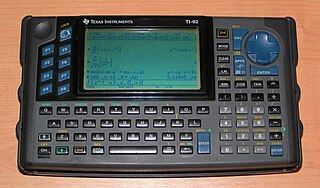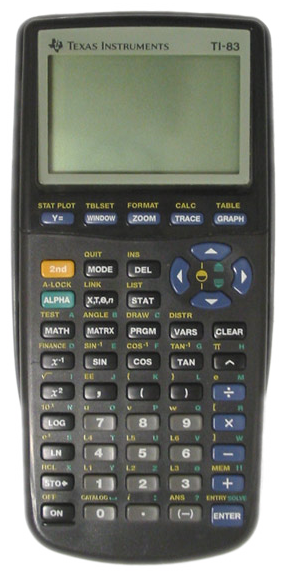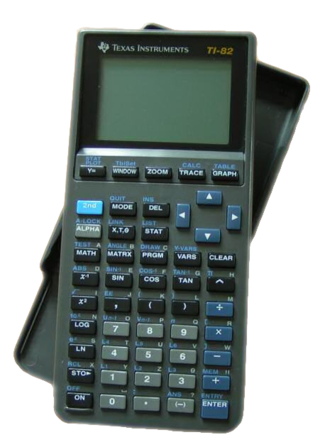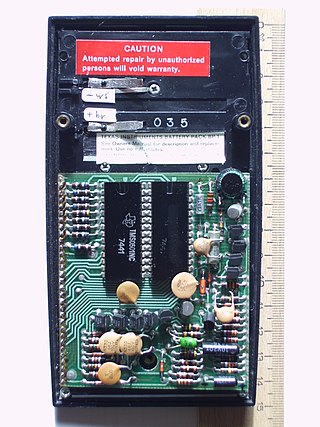
An electronic calculator is typically a portable electronic device used to perform calculations, ranging from basic arithmetic to complex mathematics.

Texas Instruments Incorporated (TI) is an American multinational semiconductor company headquartered in Dallas, Texas. It is one of the top 10 semiconductor companies worldwide based on sales volume. The company's focus is on developing analog chips and embedded processors, which account for more than 80% of its revenue. TI also produces digital light processing (DLP) technology and education technology products including calculators, microcontrollers, and multi-core processors.

The TI-89 and the TI-89 Titanium are graphing calculators developed by Texas Instruments (TI). They are differentiated from most other TI graphing calculators by their computer algebra system, which allows symbolic manipulation of algebraic expressions—equations can be solved in terms of variables, whereas the TI-83/84 series can only give a numeric result.

The TI-99/4 and TI-99/4A are home computers released by Texas Instruments in 1979 and 1981, respectively. Based on Texas Instruments's own TMS9900 microprocessor originally used in minicomputers, the TI-99/4 was the first 16-bit home computer. The associated TMS9918 video display controller provides color graphics and sprite support which were only comparable with those of the Atari 400 and 800 released a month later. The TI-99 series also initially competed with the Apple II and TRS-80.

A graphing calculator is a handheld computer that is capable of plotting graphs, solving simultaneous equations, and performing other tasks with variables. Most popular graphing calculators are programmable calculators, allowing the user to create customized programs, typically for scientific, engineering or education applications. They have large screens that display several lines of text and calculations.

The TI-92 series are a line of graphing calculators produced by Texas Instruments. They include: the TI-92 (1995), the TI-92 II (1996), the TI-92 Plus and the Voyage 200 (2002). The design of these relatively large calculators includes a QWERTY keyboard. Because of this keyboard, it was given the status of a "computer" rather than "calculator" by American testing facilities and cannot be used on tests such as the SAT or AP Exams while the similar TI-89 can be.

The TI-83 series is a series of graphing calculators manufactured by Texas Instruments.

The TI-84 Plus is a graphing calculator made by Texas Instruments which was released in early 2004. There is no original TI-84, only the TI-84 Plus, the TI-84 Plus Silver Edition models, the TI-84 Plus C Silver Edition, the TI-84 Plus CE, and TI-84 Plus CE Python. The TI-84 Plus is an enhanced version of the TI-83 Plus. The key-by-key correspondence is relatively the same, but the TI-84 features improved hardware. The archive (ROM) is about 3 times as large, and the CPU is about 2.5 times as fast. A USB port and built-in clock functionality were also added. The USB port on the TI-84 Plus series is USB On-The-Go compliant, similar to the next generation TI-Nspire calculator, which supports connecting to USB based data collection devices and probes, and supports device to device transfers over USB rather than over the serial link port. It is also able to connect to a special TI application for calculator screenshots and image download.

The TI-82 is a graphing calculator made by Texas Instruments. The TI-82 was designed in 1993 as an upgraded version of and replacement for the TI-81. It was the direct predecessor of the TI-83. It shares with the TI-85 a 6 MHz Zilog Z80 microprocessor. Like the TI-81, the TI-82 features a 96×64 pixel display, and the core feature set of the TI-81 with many new features.
TI-BASIC is the official name of a BASIC-like language built into Texas Instruments' graphing calculators. TI-BASIC is a language family of three different and incompatible versions, released on different products:

The TI 73 series is a series of graphing calculators made by Texas Instruments, all of which have identical hardware.

The TI-30 is a scientific calculator manufactured by Texas Instruments, the first model of which was introduced in 1976. While the original TI-30 was discontinued in 1983 after several design revisions, TI maintains the TI-30 designation as a branding for its low and mid-range scientific calculators.

The SR-50 was Texas Instruments' first scientific pocket calculator with trigonometric and logarithm functions. It enhanced their earlier SR-10 and SR-11 calculators, introduced in 1973, which had featured scientific notation, squares, square root, and reciprocals, but had no trig or log functions, and lacked other features. The SR-50 was introduced in 1974 and sold for US$170. It competed with the Hewlett-Packard HP-35.

The TI-59 is an early programmable calculator, that was manufactured by Texas Instruments from 1977. It is the successor to the TI SR-52, quadrupling the number of "program steps" of storage, and adding "ROM Program Modules". Just like the SR-52, it has a magnetic card reader for external storage. One quarter of the memory is stored on each side of one card.
Programmable calculators are calculators that can automatically carry out a sequence of operations under control of a stored program. Most are Turing complete, and, as such, are theoretically general-purpose computers. However, their user interfaces and programming environments are specifically tailored to make performing small-scale numerical computations convenient, rather than general-purpose use.

The Compact Computer 40 or CC-40 is an early notebook-sized computer developed by Texas Instruments. It started development in 1981, and was released in March 1983 for US$249. The CC-40 has a single-line 31 character LCD display, weighs 600 grams and is powered by an AC adapter or can operate for 200 hours on four AA batteries. Memory is not erased by turning the unit off; it can retain data for several months. The CC-40 lacks a way to store data more permanently. Software was only available on cartridge or by typing programs into its built-in BASIC interpreter. The BASIC interpreter is similar but not identical to that of the TI-99/4A.

The HP-25 was a hand-held programmable scientific/engineering calculator made by Hewlett-Packard between early January 1975 and 1978. The HP-25 was introduced as a cheaper alternative to the ground-breaking HP-65.
Texas Instruments TI-36 is a series of scientific calculators distributed by Texas Instruments. It currently represents the high-end model for the TI-30 product lines.

The TI-Nspire is a graphing calculator line made by Texas Instruments, with the first version released on 25 September 2007. The calculators feature a non-QWERTY keyboard and a different key-by-key layout than Texas Instruments's previous flagship calculators such as the TI-89 series.

The TMS1000 is a family of microcontrollers introduced by Texas Instruments in 1974.

















